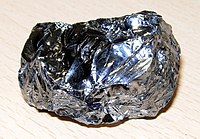
Photo from wikipedia
Engineering non-precious transition metal (TM)-based electrocatalysts to simultaneously achieve an optimal intrinsic activity, high density of active sites and rapid mass transfer ability for the oxygen reduction reaction (ORR) remains… Click to show full abstract
Engineering non-precious transition metal (TM)-based electrocatalysts to simultaneously achieve an optimal intrinsic activity, high density of active sites and rapid mass transfer ability for the oxygen reduction reaction (ORR) remains a significant challenge. To address this challenge, a hybrid composite consisting of Fex Co alloy nanoparticles uniformly implanted into hierarchically ordered macro-/meso-/microporous N-doped carbon polyhedra (HOMNCP) was rationally designed in this study. The combined results of experimental and theoretical investigations indicate that the alloying of Co enables a favorable electronic structure for the formation of the OH intermediate, while the periodically trimodal-porous-structured carbon matrix structure not only provides highly accessible channels for active site utilization but also dramatically facilitates mass transfer in the catalytic process. As expected, the Fe0.5 Co@HOMNCP composite catalyst exhibited extraordinary ORR activity with a half-wave potential of 0.903 V (versus the reversible hydrogen electrode, RHE), surpassing most Co-based catalysts reported to date. More remarkably, the use of the Fe0.5 Co@HOMNCP catalyst as the air electrode in a zinc-air battery resulted in superior open-circuit voltage and power density compared to a commercial Pt/C+IrO2 catalyst. The results of this study are expected to inspire the development of advanced TM-based catalysts for energy storage and conversion applications. This article is protected by copyright. All rights reserved.
Journal Title: Advanced materials
Year Published: 2022
Link to full text (if available)
Share on Social Media: Sign Up to like & get
recommendations!